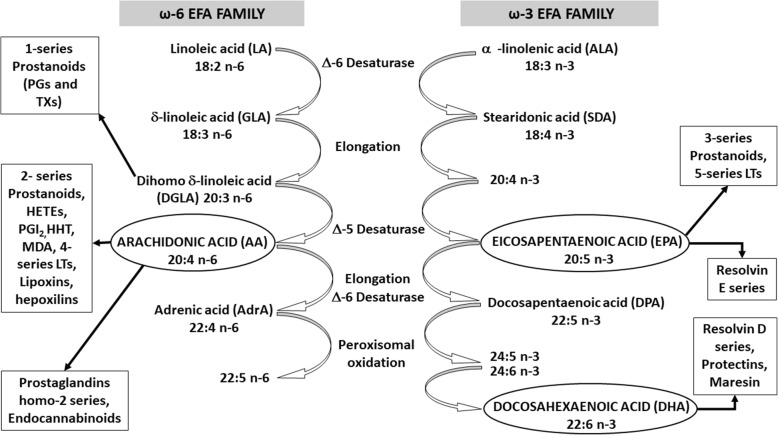Fig. 6.
Metabolism of Dietary Fatty Acids. FA are oxidized to provide energy, stored in adipose tissue, and selectively incorporated into phospholipids (PL) of all cellular membranes. Once ingested in food, they are desaturated and elongated to yield several PUFAs. PUFAs are long carbons- chained molecules having two or more double bonds of the cis configuration. ω3 and ω6 PUFAs cannot be synthesized by metazoan. They must be ingested through the diet and hence are named Essential Fatty Acids (EFAs). PUFAs ω6 derive from LA (18:2 ω6) and ω3 PUFAs arise from alpha- linolenic acid (ALA, 18:3 ω3). On the contrary, monounsaturated palmitoleic acid (POA, 16:1 ω7) and oleic acid (OA, 18:1 ω9) are easily synthesized by the body. Even though all EFAs are PUFAs not all PUFAs are essentials. In this work PUFAs and EFAs will be used as synonymous. Non-EFAs refers to monounsaturated POA and OA and their non –EFAs long chained PUFAs derivatives; also saturated fat, trans FA and cholesterol are included under this name. ALA and LA- and in certain conditions, non-EFA from the ω7 and ω9 families- compete for a common ∆5- and ∆6-desaturase and cyclo-oxygenase and lipo-oxygenase enzymes kits that are essential for the formation of long-chain metabolites such as AA, EPA and DHA from the EFAs linoleic and alpha-linolenic acids, respectively. Resulting bioactive lipids (BLs) have key, oftenly opposite, biological functions [28]. In this “race”, 18:3 ω3 ALA is desaturated preferentially, followed by 18:2 ω6 LA, thus avoiding the conversion of OA to the more highly unsaturated ω9 metabolites

